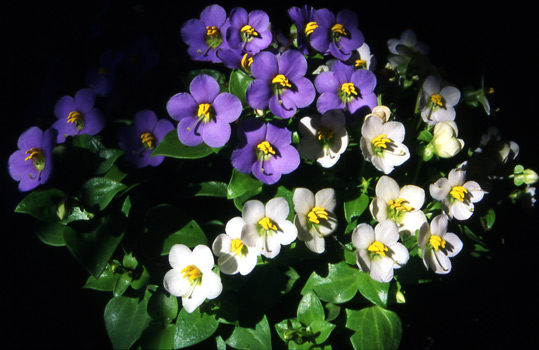Now here is something very beautiful and somewhat unusual for a warm greenhouse. Exacum affine has blue flowers with a scent, indeed a gorgeous perfume while almost all other blue flowers are scentless. (Bees are the usual pollinators for blue flowers as they can see ultra-violet / blue colours which are seldom noticed by butterflies and moths who prefer reds and yellows.)

The common name of Persian Violets is rather inappropriate (and occasionally also erroneously applied to cyclamen) as this plant is a tropical inhabitant from the island of Socotra in the far east, The other common name of Tiddly-winks is less misleading but really fails to do justice to this delightful little plant. This is a distant relation of our garden gentians but fortunately much easier to grow and flower providing you have a warm or at least frost free greenhouse or even a warm windowsill.
This is an annual, or rather a biennial, that needs sowing this month to flower next summer although it can also be propagated from cuttings once it reaches some size. Once it starts flowering it then will go on blooming all summer through and just one plant will fill the room with the most lovely scent, very sweet though not really resembling violets. The blooms themselves are coin sized pretty five petalled flowers somewhat resembling small primroses with a distinct yellow blob in the centre formed by the five pollen coated stamens.
Breeders have managed to produce variations from pale blue to dark lavender and even creamy white blooms adding to this plants attractions. It is even quite beautiful simply as a foliage plant with glossy spade shaped leaves marked with three or so longitudinal veins. The one drawback is it really does need a peat based compost (unless you can make one from leaf mould instead). Sow right now in warmth and prick out as soon as possible into individual small pots (though you can put several in together for a mixture of flowers this then stunts them somewhat). Be careful not to over-water through winter and when growth resumes in spring move them up to bigger pots, say five or six inch ones.
One important point- when the sun gets stronger in late spring and into summer move the plants out of direct sunlight into dappled shade. (This is handy as it makes space for other light hungry plants.) If you really want you can plant some out for the summer in a warm border outside but as they only ever get a foot tall at the most it means you then have to bend down to smell them- better keep them in pots up on the staging or even bring them into the house where they make excellent displays.










